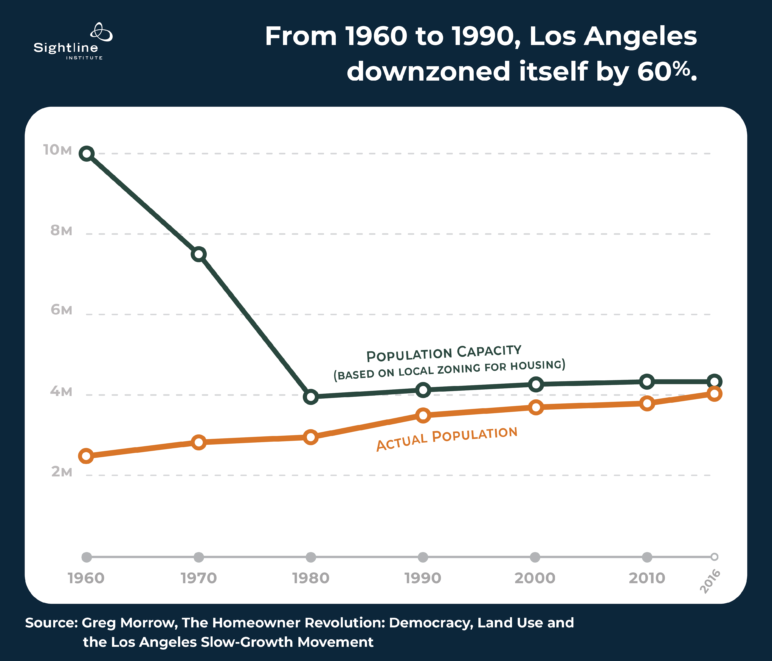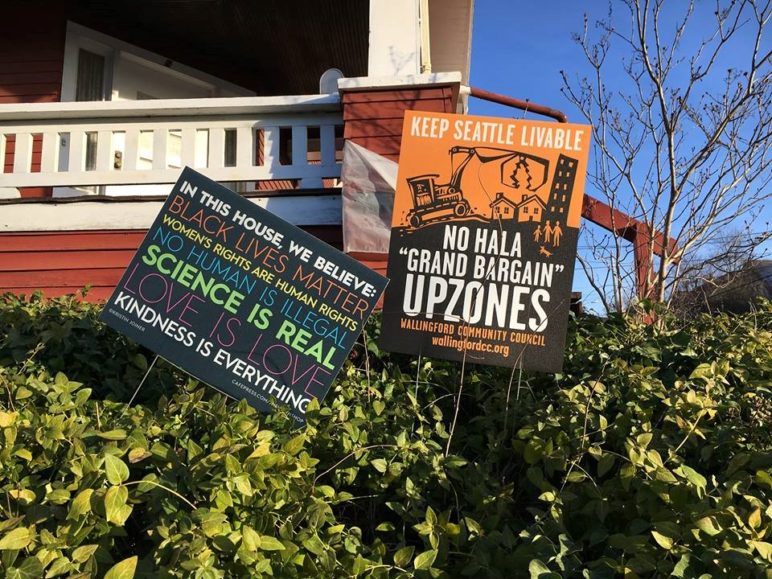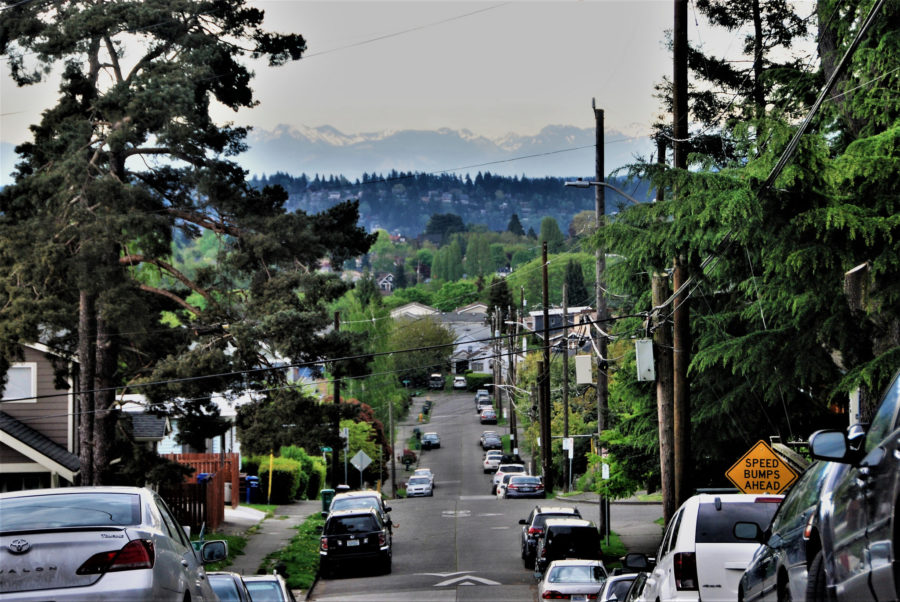Last time, I documented the consistent US pattern of housing lockdown—the cessation of homebuilding in most metropolitan areas’ residential zones, especially single-detached ones, which yields both auto-dependent, climate-polluting sprawl and expensive housing. This time, I dissect the political reasons for lockdown.
Residential lockdown—the near absence of new homebuilding in existing neighborhoods—is the norm across most of the metropolitan landscape of North America. It’s the norm even though control over homebuilding laws is thoroughly decentralized on this continent. The forces that induce lockdown must, therefore, be strong and nearly ubiquitous. I see five:
- anti-change sentiments among homeowners, turbocharged by
- financial self- interest, combined with
- homeowners’ overwhelming numerical dominance in most electorates, amplified, especially in deep-blue urban centers, by
- distrust of one subset of the people in the business of building homes (developers), and
- political gridlock produced by decades of classist and racist housing rules, now better understood but difficult to untangle. In other words, you cannot change land-use laws without navigating the politics of racially segregated cities.
Together, these political forces form a balance of power that, in the legal and legislative context of North American land-use policy-making, yields scarce housing, invisible walls of exclusion, and megatons of greenhouse gas emissions.
Case in point: Los Angeles
Vast areas of North American cities started out with more permissive rules and have ratcheted down to the most restrictive type: one house per lot. Once zoned this way, vanishingly few neighborhoods have rebounded to more welcoming rules.
In Los Angeles, for example, University of California, Berkeley, scholar Greg Morrow documented this ratcheting of restrictions in The Homeowner Revolution. After 1965, the city shifted planning power to neighborhood councils, and these groups, Morrow learned by studying all 104 community plans that these homeowner-dominated groups developed, systematically downzoned the city. Their plans shrank the city’s legal capacity to house people by 60 percent over three decades, as shown in the figure below.

Original Sightline Institute graphic, available under our free use policy.
The long-term effect on Los Angeles was a transformation as complete as any it had seen before: from a land of inequitably distributed abundance into a land of citywide shortage. By 2016, the former boomtown—the capital of human imagination—was almost completely closed: some 93 percent of bedrooms that were legal to build were already constructed and occupied. No wonder housing prices are high! Los Angeles had become what Economist correspondent Ryan Avent calls a “gated city.”
Homeowners’ interests
LA’s homeowners, given control of their city, acted upon what appears to be homeowners’ least-common-denominator political impulse everywhere: to resist and obstruct the addition of new housing to their neighborhoods. In community meetings, private conversations, and opinion surveys, the motives they express are far from uniform. Some like the neighborhood as it was when they moved in. Others like the space or the quiet, the privacy or the greenery, the independence or the uncrowded streets (and parking spaces), the appearance of the houses, or the neighborliness they feel with people who share similar life experiences. Some few state—and others probably feel but do not state aloud—that they prefer not to live near people from a lower economic class, another race, or another ethnicity. (Indeed, historically speaking, such social exclusion was a clear motive for zoning codes’ original adoption in many places, whether homeowners today prefer it or not.)
Whatever their other feelings, though, most homeowners are also moved, whether weakly or strongly, by an underlying and often unspoken motive: financial self-interest. For most North Americans who own homes, that home is their principal asset. It is not only where they live but also their main savings account. Citywide scarcity of housing puts more money into that account: it makes their homes worth more money. The dual nature of home ownership—residence and nest egg—is essential to understanding homeowners’ political behavior about zoning. That behavior, often labeled NIMBYism, is perhaps better termed housing obstructionism.
Homevoters
Homeowners’ views manifest powerfully in politics. Elections in North America, especially local elections, are utterly and overwhelmingly dominated by homeowners. Among registered voters, owners are more likely than renters to turn in ballots—typically 25 percent more likely. David Mermin of Lake Research Partners, a political polling firm in California, says that 53 percent of that state’s registered voters are homeowners, roughly in line with the state’s population. But of those Californians who voted in the high-turnout 2016 general election, some 60 percent were homeowners. In the lower-turnout primary election that same year, homeowners made up 67 percent.
Even in big cities such as Seattle, where renters now match homeowners in numbers and outnumber them among the voting-age population, homeowners still send in the lion’s share of ballots. In Seattle’s 2019 primary election for city councilors, which had near-record high turnout, homeowners still made up 62 percent of the electorate, down from 67 percent in the more typical 2015 primary. And 67 percent of primary election voters does not reflect the full magnitude of homeowner dominance in elections. Outside of big-city Cascadia, where homeowners make up a larger share of the population than in California, the numbers skew even more strongly toward owners. Pollster Ben Patinkin says that in the 2010 midterm general election and a 2011 special election in Washington—the most recent campaigns for which he tabulated detailed numbers on homeownership—owners averaged 85 percent of voters. Eighty-five percent!
The homeowner skew of the voting population has two explanations. First, homeowners tend to have traits that correlate with voting: higher education levels and socio-economic status, more income and wealth, and more years living in the same place. Second, they are more likely to vote because they are homeowners; that is, owning a home motivates you to cast a ballot. You are especially prone to vote on local issues that may affect the value of your home, like a zoning measure. And the more expensive your house is, the more likely you are to vote. To a sometimes shocking degree, people really do tend to vote their home values. That’s why Dartmouth economist William A. Fischel coined the term “homevoters” to encapsulate his academic theory that most local government decisions are a simple extension of whatever will protect or increase local property values.
Antideveloper sentiment
As the Niskanen Center’s Will Wilkinson writes in The Density Divide: Urbanization, Polarization, and the Populist Backlash, “there is now no such thing as a Republican city.” In the United States, population density is now one of the best predictors of voting behavior. Metro areas are blue; rural areas are red. The US population has now sorted itself into metro and non-metro camps. Most of the metro areas are prospering, progressive, high-education, and multicultural; most rural areas are economically sluggish, conservative, low-education, and white. The former generate the lion’s share of innovation, economic output, and jobs and are home to a large majority of people. The latter continue to hold onto political power because of quirks of US democracy: gerrymandered Congressional districts; the constitutional gerrymander of the US Senate, which over-represents predominantly rural, small-population states; and the spillover effect of the Senate’s overrepresentation of small-population states in the Electoral College. Each state gets one elector in the college for each US Senator and one for each member of the US House, so votes in small-population states such as Alaska and Wyoming count about three times more for US President than do votes in large-population states such as California.
The density-is-politics pattern is now so reliable that you can usually find the line between majority blue and majority red precincts just by mapping population density: 1.4 people per acre is the blue-red boundary around most cities. (For a rough sense of that number, it’s about the perimeter where average house lot size reaches two acres.)
Closer to the core of metro areas, though, politics are deep blue. In US urban centers, as opposed to in suburbs and exurbs, the political battle is not left versus right anymore. It’s far left versus center left. In Seattle proper, for example, only 8 percent of voters marked their ballots for Donald Trump in 2016. In one precinct of Wallingford, a liberal and famously housing obstructionist single-detached neighborhood, not a single person voted for Trump. This confluence of liberal ideology and exclusionary housing sentiment is much noted by the commentariat. What explains this confluence of beliefs?

A common sight in Wallingford during Seattle’s HALA debate over upzones: households that espouse both arch-liberal views and housing obstructionism. Photo by Rick Mohler, used with permission.
In the mid-nineties, Joel Horn, leader of the ill-fated attempt to build the Seattle Commons, a new park close to downtown Seattle, told me, “Seattle voters will support good projects, as long as no one gets rich.” Recent research suggests that he was exactly right. People are much more likely to oppose a new building if the interviewer tells them that the person who is constructing it will profit handsomely. In fact, opposition increases by 20 percentage points, more than in response to any other argument. The researchers observe that opponents of new buildings appear not just to be motivated by the potential downsides to themselves of a big new building, that is, by self-interest, but also by a desire to punish developers. If so, something about the process of building new homes that fill in existing neighborhoods may be tapping a deep human urge—the powerful impulse to punish cheaters and enforce fairness that is one of the keys to our success as a social species.
This reaction may be particularly pronounced in cities, where new housing is closest to existing neighbors and where liberal views of housing (as a human right) and community (as mattering as much as individual property rights) are strongest.
These beliefs are perhaps most pronounced on the political left, among those most critical of a market economy, and by those who work the hardest to rectify the market housing economy’s shortcomings. People in the affordable housing sector, including subsidized housing providers and tenants’ advocates—“housers,” they sometimes call themselves—are relatively few in number in every city, but they carry political credibility beyond their numbers. They are persuasive messengers for a viewpoint held by many liberals, including homeowners: that housing is a right, and there’s something unseemly or even immoral about profiting from it.
The combination of homeowners’ opposition to change, their dominance of elections, and peoples’—especially liberals’—instinctive distrust of for-profit developers creates a powerful and stable political alignment in most US cities. This alignment of self-interest and conscience keeps housing in lockdown, not only in far-flung suburbs but also in many inclusion-minded, deep-blue centers of metro areas. This axis is rarely a formal political coalition, but the forces typically push toward the same policies. Homeowners, housers, and the left all favor tight regulation and stiff taxation of developers—homeowners to stop change and housers and the left because, in their world view, limiting the power of the market is the path to a future in which many more people live in social housing—homes that are free from the speculation and commodity logic of the real-estate market.
Personally, I’m sympathetic to the worldview of housers and the left, but I’m convinced (and have argued) that making social housing the be-all-and-end-all of housing policy is a ruinous mistake as a guide to political strategy. North America will never, in time to respond to climate change or housing shortages, throw over the trillions of dollars of residential asset values currently held by majorities of the population in favor of some less-capitalist housing economy, such as a Vienna- or Singapore-like social-housing model. Sure, we will provide some social housing—I hope much more than in the past—but it will in the foreseeable future be a sideline to the juggernaut of the private market. In Cascadia at present, social housing as a share of all housing is in the single digits. Indeed, well under 20 percent of low-income families and individuals live in subsidized housing of any type, and while increasing that percentage is an urgent goal, a complementary strategy that costs nothing to the public treasury is to stop banning the kinds of modest, inexpensive homes that once housed almost all North Americans of limited means. In addition to social housing, we’ll need to empower entrepreneurship and private investment and convert, coopt, splinter, out-organize, or outflank the obstructionist forces that keep privately built housing in lockdown.
Race and displacement
All of this would be politically difficult enough to do even without the urgency of also responding on an appropriately ambitious scale to the demands of justice for historical wrongs.
The racist history of urban development in North America—racially and ethnically restrictive zoning and covenants, redlining, block busting, urban renewal (“Negro removal,” James Baldwin called it), overtly or implicitly racist rental and sales practices—makes urban land-use the furthest thing from a neutral, technocratic area of policymaking. Cascadia’s cities are somewhat less geographically segregated by race and ethnicity than other cities, but they are still segregated. Every proposed change to zoning maps cuts across the sedimentary layers of injustice and sets off landslides of well-founded indignation, distrust, and resistance.
Because so many human preferences, prejudices, loves, and hates get capitalized into land values, the entire ugly history of racial oppression on this continent is still with us. It’s etched into real-estate values and, therefore, household net worth and life prospects. Parental wealth, after all, is far more predictive of children’s future education, income, and well-being than is mere parental income. Long-illegal practices such as redlining remain visible in current maps of property values. Racially discriminatory practices in the housing market have been one of the principal mechanisms through which racism has transmuted itself into class structure in the United States. Excluded for generations from the great escalator ride of rising home values, people of color have ended up with far less net worth than whites: African-Americans, for example, have one-tenth the family wealth, on average.
Consequently, for many people of color—shunted into disadvantaged and neglected sectors of town, unable to hold onto their places when those with more money want them—the proposition that private real estate development undertaken by outsiders, often white, will be a good thing for them can seem, at the very least, an insult.
Why should they believe anyone telling them that, this time, it will be different? There is compelling, new, hyperlocalized evidence, based on enormous data sets, that building many more homes in neighborhoods has almost no net effect on displacement in those neighborhoods but does lower rents, even in buildings very close to the new ones being built (contrary to popular perceptions), and helps neighborhood children. But communities of color, put-upon and done-to for generations, understandably tend to distrust such arguments and resist change. They justifiably aim to assert at least influence, if not control, over communities they have built through living there, even if others own the land and the buildings.
Infuriatingly, they rarely get much of that influence. These communities are sometimes left able to do nothing but resist change, not steer it in the directions to which many of their members aspire—local control and ownership, community stability and development, prosperity on their own terms. And this resistance too, ironically, contributes to housing lockdown across North America. In the absence of strong constituencies pushing for change, the status quo almost always prevails. And the status quo is to leave in effect age-old homebuilding limits, many of them little changed in single-detached zones since the 1920s.
There is much more to say about race and displacement and strategies that can respond meaningfully to the pressures of new development. It’s a topic that deserves treatment at length. Because it’s both important and complicated, I’ll devote a full article to it, soon.
But first, next time, I’ll recount one of the most consequential recent attempts to break out of residential lockdown: a Seattle plan called the Housing Affordability and Livability Agenda (HALA).
Next time: A look at a local attempt to forge a new, progressive, pro-housing axis.











L L
Shame on you. I’m a low-income renter from a marginalized community and was a South King county resident for more than 20 years and I want more trees and protection of existing mature trees in Seattle. It has nothing to do with affordable housing, it has to do with the health of my family, my community and my planet. I don’t need a white male time to tell me what people of color need.
Queer
If you are so concerned about trees, I hope you have planted some in your yard, the only solution.
Seattle is in no position to demand control of property owners’ trees when the city has a multi-million dollar backlog in its tree maintenance. Seattle has not maintained it’s trees and in doing so has allowed dangerous monocultures of trees to dominate. Proof is that property owners have a higher number of non-junk trees i.e. evergreens which are significantly better for the environment.
Passing new feel good laws to protect trees from homeowners and developers will make an insignificant difference in tree coverage. The new laws will do nothing to enhance the health of families, our community nor our planet.
The only way to make any difference is build with density, protect from urban sprawl and plant a tree everywhere there is a grass lawn.
Greg Francis
Thank you for this article! It succinctly states a number of the things that I’ve mulled around with as I ponder ways to increase housing density in our city (Spokane). The resistance I see extends across all aspects of the political spectrum with different arguments used to justify inaction depending on their beliefs. It extends well beyond traditional NIMBYism as we face paralysis in making change happen. Too often, I feel that we can only expect change at the state level because there just isn’t the political will to make it happen locally even though everyone says that more housing is needed.